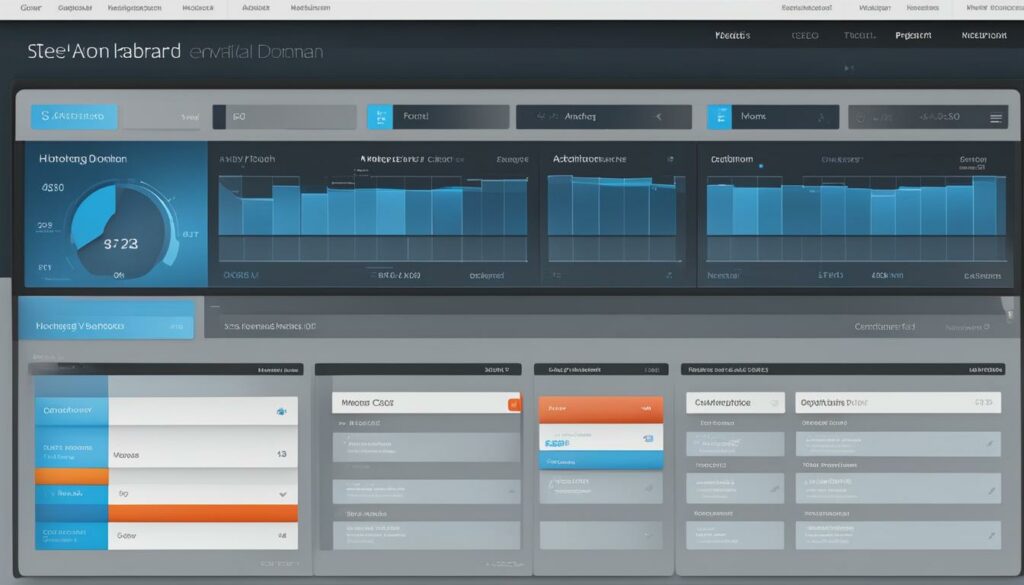Building an online store with WordPress can be intimidating, but with the right tips and practices, you can ensure success. In this article, we will explore the essentials you need to get started, including choosing a domain name and finding the right web host for e-commerce. We’ll also discuss the best WordPress e-commerce plugins and themes, as well as strategies for driving traffic and improving conversion rates. By following these steps, you can leverage the power of WordPress for e-commerce and elevate your online store.
WordPress offers a range of features and options for creating a robust e-commerce website. With the flexibility and customization capabilities of WordPress, you can design a unique online store that caters to your specific needs. Whether you’re a small business owner or an aspiring entrepreneur, WordPress provides the tools to build and grow your e-commerce presence.
Key Takeaways:
- WordPress is a powerful platform for building e-commerce websites.
- Choosing a domain name and finding the right web host are crucial steps in setting up your e-commerce store.
- There are several WordPress plugins and themes specifically designed for e-commerce websites, such as WooCommerce.
- Driving traffic to your online store can be done through strategies like SEO, Google Ads, and social media marketing.
- Improving conversion rates requires optimizing product images, reducing loading time, and providing excellent customer service.
Essentials You Need to Get Started
Before diving into building your e-commerce website with WordPress, there are a few essential steps you need to take. First, you’ll need to choose a domain name that accurately represents your brand. Next, you’ll need to find the right web hosting provider that offers privacy, security, and fast loading times. These two steps are the foundation of your e-commerce website and will set you up for success.
- Choosing a Domain Name: Your domain name is the web address that visitors will use to reach your online store. It should reflect your brand and be easy to remember. Consider using relevant keywords that describe your products or services to improve search engine visibility.
- Finding the Right Web Host for E-commerce: A reliable web host is crucial for the smooth operation of your e-commerce website. Look for a host that specializes in WordPress hosting for optimal performance. BoostedHost is highly recommended for their exceptional WordPress hosting services.
BoostedHost offers WordPress Hosting plans tailored to meet the unique demands of e-commerce websites. With their advanced infrastructure, lightning-fast page load speeds, and robust security measures, you can trust BoostedHost to provide the reliability, performance, and support you need for your e-commerce WordPress website. Sign up now by clicking on the image below:
“Choosing the right domain name and web host for your e-commerce WordPress website is essential for its success. A memorable domain name that reflects your brand and a reliable web host like BoostedHost will ensure privacy, security, and fast loading times, providing a solid foundation for your online store to thrive.”
E-commerce Store Basics
Once you have your domain name and web hosting in place, it’s time to start building the basic components of your e-commerce store. This includes creating product pages that showcase your products with high-quality images and compelling descriptions.
To create product pages:
-
Choose appealing images: Use high-resolution images that accurately represent your products. Showcase different angles and highlight unique features to entice your customers.
-
Write compelling descriptions: Describe your products in detail, emphasizing their benefits and unique selling points. Use persuasive language to captivate your customers’ attention and compel them to make a purchase.
-
Organize your products: Categorize your products into relevant categories or collections to make it easy for customers to browse and find what they’re looking for.
In addition to creating product pages, you’ll need to ensure a smooth and seamless shopping experience for your customers by adding a shopping cart and checkout system. This will allow them to easily select and purchase products from your e-commerce store.
To add a shopping cart and checkout system:
-
Choose a reliable e-commerce plugin: WordPress offers several plugins that can seamlessly integrate a shopping cart and checkout system into your website. One popular option is WooCommerce, which provides a user-friendly interface and robust features for managing orders and payments.
-
Configure payment gateways: Set up secure and convenient payment options for your customers. WooCommerce supports various payment gateways, including PayPal, Stripe, and Authorize.net.
-
Customize the shopping cart: Personalize the appearance and functionality of your shopping cart to align with your brand. You can adjust settings such as cart behavior, shipping options, and tax calculations.
-
Optimize the checkout process: Make the checkout process user-friendly and efficient. Minimize the number of required form fields and offer guest checkout options to reduce friction and increase conversion rates.
By creating an engaging product page and implementing a smooth shopping cart and checkout system, you’ll provide your customers with a seamless e-commerce experience that encourages them to make purchases.
In the next section, we will explore the best WordPress e-commerce plugins to enhance the functionality of your online store.

The Best WordPress E-commerce Plugins
To enhance the functionality of your e-commerce store, there are several WordPress e-commerce plugins you can utilize. The most popular option is WooCommerce, which offers a wide range of features, including inventory management, payment gateways, and reporting. Another option is Easy Digital Downloads, which is ideal for selling digital products. These plugins can transform your WordPress website into a fully functioning online store with ease.
| Plugin | Features |
|---|---|
| WooCommerce | Inventory management, payment gateways, reporting |
| Easy Digital Downloads | Ideal for selling digital products |

With WooCommerce, you can easily set up and manage your online store, customize your website’s design, and track your sales and inventory. It provides a user-friendly interface, making it accessible to both beginners and experienced e-commerce store owners. Additionally, you can expand the functionality of your online store by adding various extensions available in the WooCommerce marketplace.
Easy Digital Downloads, on the other hand, is specifically designed for businesses that sell digital products such as ebooks, music, software, and more. It offers a seamless shopping experience for customers and provides robust features to manage and deliver digital products securely.
Whether you’re selling physical products or digital downloads, these WordPress e-commerce plugins provide the tools you need to create a successful online store with minimal hassle. Choose the plugin that best suits your needs and start optimizing your e-commerce website for increased sales and customer satisfaction.
The Best WordPress E-commerce Themes
In addition to plugins, choosing the right WordPress e-commerce theme is crucial for ensuring the success of your online store. Your selected theme should be mobile responsive, meaning it looks and functions well on various devices such as smartphones and tablets. This mobile responsiveness is essential in today’s digital landscape, where people increasingly shop on their mobile devices.
Furthermore, your chosen WordPress e-commerce theme should support e-commerce plugins. This compatibility ensures that your website seamlessly integrates with the necessary functionalities required for an online store, such as shopping carts, product catalogs, and secure payment gateways.
Customizability is another crucial factor to consider when selecting a WordPress e-commerce theme. It allows you to personalize your website and tailor it to your brand’s unique identity. By choosing a customizable theme, you can create a visually appealing and immersive shopping experience for your customers.
Two popular WordPress e-commerce themes that meet these criteria are Divi and Extra.
Divi: A versatile and powerful theme, Divi offers a drag-and-drop builder that simplifies website design. It features numerous pre-designed templates, making it easy to create stunning product pages, landing pages, and overall website layouts. Divi is highly customizable and provides various e-commerce features, including product filtering, shopping carts, and user reviews. Its responsive design ensures your online store looks great on any device.
Extra: Designed specifically for e-commerce websites, Extra offers a magazine-style layout with dynamic content modules. Its content-focused approach allows you to create engaging product pages and blog posts, helping you effectively showcase your products and drive conversions. Like Divi, Extra is fully customizable and mobile responsive, guaranteeing a seamless shopping experience for your customers.
By choosing a WordPress e-commerce theme like Divi or Extra, you can create a visually appealing and feature-rich online store that entices customers and drives sales.

How to Drive Traffic to Your Online Store
Once your e-commerce store is up and running, it’s essential to drive traffic to your website. By implementing effective strategies, you can increase your online visibility and attract potential customers to your online store.
Visitor Tracking with Google Analytics
One of the first steps in driving traffic to your online store is to gain insights about your audience. Implementing visitor tracking with Google Analytics allows you to gather valuable data about your website visitors. You can track metrics such as the number of visitors, their geographical location, the pages they visit, and even their behavior on your website. By analyzing this data, you can make informed decisions to optimize your website and tailor your marketing efforts to target specific demographics.
Search Engine Optimization (SEO)
Optimizing your e-commerce website for search engines is crucial to improve your website’s visibility and attract organic traffic. Conduct keyword research to identify the phrases and terms potential customers are searching for in your industry. Incorporate these keywords strategically in your website’s content, including product descriptions, blog posts, and meta tags. Additionally, optimize your website’s loading speed, improve its mobile responsiveness, and ensure a user-friendly browsing experience. These SEO practices will help your website rank higher in search engine results and drive traffic to your online store.
Utilizing Google Ads and Google Shopping
Google Ads is an effective paid advertising platform that can drive targeted traffic to your e-commerce website. You can create compelling ad campaigns that appear on relevant websites, search results, and Google Shopping. Google Shopping is particularly useful for e-commerce stores, as it allows potential customers to view product listings directly in the search results. By leveraging Google Ads and Google Shopping, you can increase your visibility and attract customers who are actively searching for products like yours.
Social Media Marketing
Social media platforms provide a vast audience and an opportunity to engage with potential customers on a personal level. Develop a social media marketing strategy that aligns with your target audience and business goals. Create engaging content, including product highlights, promotions, and behind-the-scenes glimpses of your brand. Encourage your followers to share your content and engage with your posts. Engaging with your audience and building strong relationships on social media can significantly increase your website traffic and drive potential customers to your online store.
Content Marketing
Creating valuable and informative content is an effective way to attract organic traffic and engage potential customers. Develop a content marketing strategy to produce relevant blog posts, videos, and guides that address the pain points and interests of your target audience. Optimize your content with relevant keywords and share it across your website, social media channels, and other relevant platforms. Valuable content not only drives traffic to your online store but also establishes your brand as a trusted authority in your industry.
Email Marketing
Utilize email marketing to connect with potential customers and drive traffic to your online store. Build an email list by offering incentives such as discounts or exclusive content in exchange for email sign-ups. Send regular newsletters, personalized product recommendations, and promotional offers to your subscribers. Craft compelling subject lines and engaging content that entices recipients to click through to your website. By leveraging email marketing effectively, you can nurture leads, drive repeat business, and increase website traffic.
By implementing these strategies, you can effectively drive traffic to your online store, increase your visibility, and attract potential customers. Experiment with different tactics, analyze your results, and continuously optimize your marketing efforts to maximize your e-commerce success.
How to Improve Your Store’s Conversion Rates
Converting website visitors into paying customers is the ultimate goal of your e-commerce store. To improve your conversion rates and boost your online sales, consider implementing the following strategies:
1. Optimize Your Product Images: High-quality and visually appealing product images can significantly impact customer purchasing decisions. Make sure your product images are clear, well-lit, and showcase your products from different angles. Highlight any unique features and include alt tags with relevant keywords to improve search engine visibility.
2. Ensure Fast Loading Times: A slow-loading website can frustrate users and lead to high bounce rates. Optimize your website’s loading time by compressing images, minifying CSS and JavaScript files, and utilizing caching plugins. Providing a seamless user experience will encourage visitors to stay on your site and make a purchase.
3. Provide Excellent Customer Service: Outstanding customer service can build trust and loyalty. Ensure that your customer service team is easily accessible and responsive to inquiries, issues, and feedback. Offer multiple contact options, such as live chat, email, and phone support, to cater to different customer preferences.
4. Implement Proactive Cart Abandonment Strategies: Cart abandonment is a common challenge for e-commerce stores. To reduce cart abandonment rates, implement strategies such as sending reminder emails to customers who have abandoned their carts, offering incentives or discounts, and simplifying the checkout process with guest checkout options.
By focusing on optimizing your product images, improving loading times, providing exceptional customer service, and tackling cart abandonment, you can enhance your store’s conversion rates and drive more sales.
E-commerce Tips Final Thoughts
With the right tips and strategies, you can achieve success with your WordPress e-commerce store. Here are some key insights to help elevate your online store and ensure its success:
Choose the Right Plugins and Themes
Utilize the best WordPress e-commerce plugins and themes to enhance the functionality and design of your online store. WooCommerce is a popular choice with its comprehensive features, while Easy Digital Downloads is ideal for selling digital products. These plugins can transform your WordPress website into a fully functional online store.
Drive Traffic and Improve Conversion Rates
To attract visitors and turn them into customers, employ effective strategies to drive traffic to your online store. Utilize tools like Google Analytics to track visitor behavior and optimize your website’s performance. Implement search engine optimization (SEO) techniques, run Google Ads and Google Shopping campaigns, engage in social media marketing, create valuable content, and leverage email marketing to reach potential customers.
Continually Analyze Performance and Adapt
Regularly analyze your store’s performance by monitoring metrics such as traffic, conversion rates, and customer feedback. Adapt your strategies based on the insights gathered to improve user experience, optimize marketing efforts, and address any issues that may arise. By staying proactive and adaptive, you can continually enhance your online store’s success.
Remember, the success of your WordPress e-commerce website relies on providing a positive shopping experience for your customers. It’s crucial to prioritize user experience, offer excellent customer service, and tackle cart abandonment effectively. By following these e-commerce tips and best practices, your WordPress e-commerce store will thrive in the competitive online marketplace.
Conclusion
WordPress offers a wide array of powerful tools and plugins that can transform your ordinary website into a thriving e-commerce store. By following the best practices outlined in this article, you can leverage the immense potential of WordPress to achieve e-commerce success. Whether you are just starting out or looking to optimize your existing e-commerce WordPress website, these strategies will help you maximize your online sales and achieve your business goals.
Setting up your e-commerce WordPress website is just the beginning. By carefully selecting a domain name that reflects your brand and finding the right web hosting provider like BoostedHost, you can ensure optimal performance for your store. Additionally, integrating the best WordPress e-commerce plugins, such as WooCommerce or Easy Digital Downloads, will enhance the functionality of your website, allowing you to manage inventory, accept payments, and generate insightful reports.
Driving traffic to your online store is essential for success. Implementing visitor tracking with tools like Google Analytics, employing effective search engine optimization (SEO) techniques, running Google Ads and Google Shopping campaigns, leveraging the power of social media and content marketing, and utilizing email marketing can all contribute to increasing the visibility and reach of your e-commerce store.
To improve your store’s conversion rates, pay attention to key elements such as optimizing product images, ensuring fast loading times to provide a seamless user experience, delivering exceptional customer service, and implementing strategies to tackle cart abandonment. By addressing these factors, you can foster trust, engage customers, and encourage more sales.
Now is the time to start implementing these practices and watch your WordPress e-commerce store thrive. With WordPress as your platform of choice, combined with the right tools, plugins, and strategies, your e-commerce website has the potential to stand out in the highly competitive online marketplace. Sign up for WordPress Hosting from BoostedHost for optimal performance and start building your successful e-commerce store today.
FAQ
Q: How can I leverage WordPress for e-commerce success?
A: To leverage WordPress for e-commerce success, you need to choose a domain name that represents your brand and find a reliable web hosting provider.
Q: What are the essentials for getting started with WordPress e-commerce?
A: The essentials for getting started with WordPress e-commerce include choosing a domain name and finding the right web hosting provider.
Q: What are the basic components of an e-commerce store built with WordPress?
A: The basic components of an e-commerce store built with WordPress include product pages, a shopping cart, and a checkout system.
Q: What are the best WordPress e-commerce plugins?
A: Some of the best WordPress e-commerce plugins include WooCommerce and Easy Digital Downloads.
Q: Which WordPress e-commerce themes are recommended for online stores?
A: Recommended WordPress e-commerce themes for online stores include Divi and Extra, which are mobile responsive and support e-commerce plugins.
Q: How can I drive traffic to my WordPress e-commerce website?
A: You can drive traffic to your WordPress e-commerce website by employing strategies such as visitor tracking with Google Analytics, search engine optimization (SEO), Google Ads, Google Shopping, social media marketing, content marketing, and email marketing.
Q: What can I do to improve conversion rates on my e-commerce store?
A: To improve conversion rates on your e-commerce store, focus on optimizing your product images, ensuring fast loading times, providing excellent customer service, and implementing strategies to tackle cart abandonment.
Q: What are some final tips for e-commerce success with WordPress?
A: Some final tips for e-commerce success with WordPress include continuously analyzing your performance, adapting your strategies, and providing a positive shopping experience for your customers.












